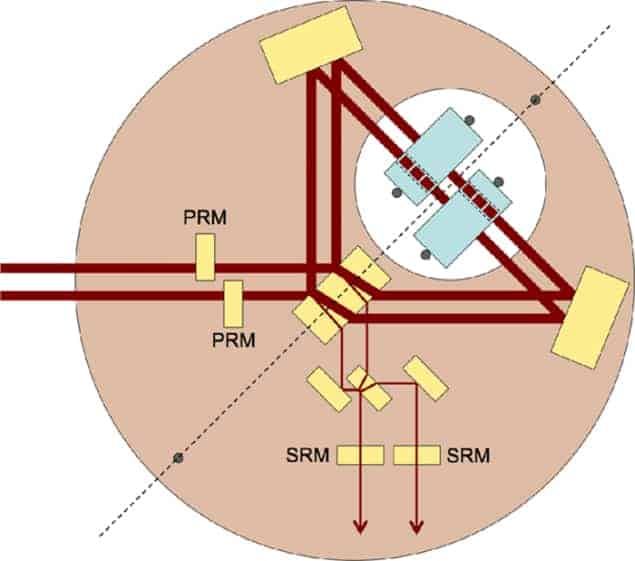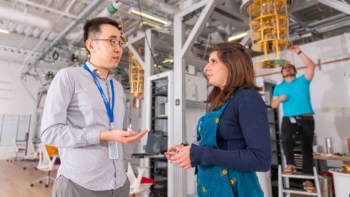
An experiment that could lead to the quantum-mechanical entanglement of everyday objects in the form of two 100 g mirrors has been proposed by Roman Schnabel of the University of Hamburg and the Max Planck Institute for Gravitational Physics in Germany. If successful, the mirrors would be by far the largest objects ever to be entangled, and the experiment would confirm that quantum physics applies to large and heavy objects, not just tiny particles. It could also test a prediction made in 2010 about how the mutual gravitational attraction of the mirrors affects their entanglement.
Entanglement is a purely quantum-mechanical phenomenon that allows two particles, such as photons or electrons, to have a much closer relationship than is predicted by classical physics. The concept of entanglement was introduced in the 1930s when physicists were debating the seemingly bizarre implications of quantum mechanics as identified by the Einstein–Podolsky–Rosen (EPR) paradox. EPR points out that if two particles are entangled and separated by some distance, then a measurement made on one particle seems to instantaneously affect the outcome of a measurement made on the other particle. Since no communications can travel between the particles faster than the speed of light, EPR surmises that “hidden variables” unknown to the experimenter have caused the effect. In 1964 John Bell came up with a way of disproving the existence of hidden variables – by a violation of Bell’s inequality – and subsequent experiments have confirmed that entanglement cannot be explained by hidden variables.
Since then, entanglement has become a fascinating phenomenon for physicists to study and has also found practical application in quantum-encryption systems. Indeed, over the past decade or so, physicists have been successful at entangling ever-larger objects, including micron-scale mechanical resonators. Now, Schnabel has come up with a way to entangle two mirrors that are enormous in comparison with previously entangled objects.
Swapping entanglement
The mirrors are entangled via photon radiation pressure and a process called entanglement swapping. This is done by placing two mirrors into a Michelson-type interferometer (see figure). Two beams of light are sent into the interferometer so that each mirror is struck on both sides by light. As light travels through the system, it is reflected from the surfaces of the mirrors. If the mirrors are free to oscillate, then momentum can be transferred between the mirrors and the light. The motion of the mirrors will also affect the phase of the light that is reflected from them. In this way, the light in the interferometer and the motion of the mirrors becomes entangled.
This entanglement is then “swapped” to become an entanglement between the two mirrors. This is done by measuring the interference of the two light beams as they exit the interferometer. Crucially, this measurement provides information about the nature of the entanglement but does not destroy it because the measurement does not provide any information about an individual mirror. The Michelson-type interferometer is ideal for this because it can be set up to measure the relative difference between the positions of the mirrors and the relative difference between the momenta of the mirrors – but not the individual positions and momenta of each mirror.
Once entanglement is achieved, the next step is to verify that the motions of the mirrors are indeed entangled. This involves switching off the light to allow the system to evolve for a few milliseconds before further measurements are made. Then the set-up is modified by removing one beamsplitter, which allows the experimenter to measure the position and momenta of each mirror individually.
Repeated measurements
In a practical experiment, the mirrors would be entangled, allowed to evolve for a few microseconds and then have their positions and momenta measured. This would be repeated over and over again, and the presence of entanglement would be signalled by correlations between the measured properties of the mirrors that are greater than those allowed by classical physics.
Schnabel and colleagues have already started building the experiment in the lab, but Schnabel says that there are several important practical challenges that must be overcome. The most significant challenge will be how to cool the mirrors to a temperature of about 4 K and how to keep them isolated from their surroundings so they do not absorb heat energy, which would affect their motion and destroy entanglement.
If they can realize the experiment, Schnabel and colleagues will prove that not only small particles can show quantum behaviour, but also massive objects. If successful, they will also be able to test a prediction made in 2010 by Haixing Miao – then at the University of Western Australia – and colleagues. This group calculated that the mutual gravitational energy of the mirrors would destroy the entanglement on the microsecond timescale, which is something that Schnabel’s experiment should be able to see.
Earlier this year, Schnabel and colleagues demonstrated a new way of cooling a mirror using light in a Michelson interferometer (see “Physicists reveal new way of cooling large objects with light”).
The experimental proposal is described in Physical Review A.



